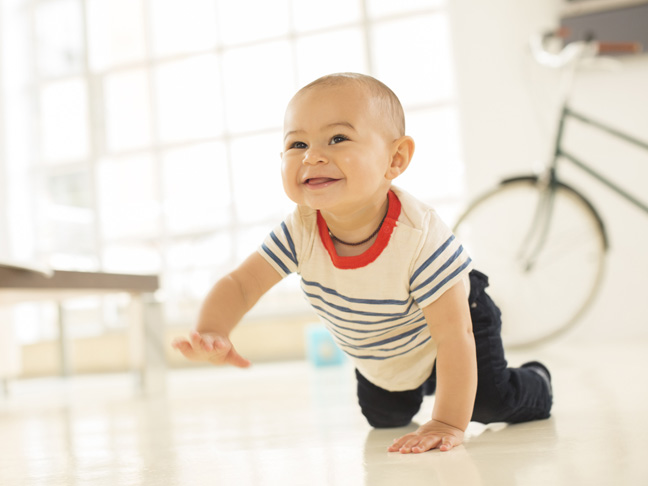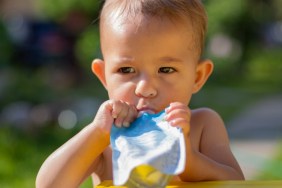My daughter started walking when she was ten months old. My son, however, was well over thirteen months. I tried not to compare the two, because I know every baby is different, but—come on—it’s kind of hard not to liken my second born to my first, at least a little bit. When I’m at the playground and I see a little girl roughly eighteen months old, the same age as my son, and she’s having a full on intelligible conversation with her mother, I can’t help feeling a little jealous. At nineteen months my son has only a handful of words, and most of them are missing the last syllable.
So, what is normal? It’s easy to compare your child to the whiz kid crawling across the floor or the toddler wiping his own butt on the toilet while yours hovers in the corner dropping a deuce in his diaper for the billionth time. The best thing to do is not compare your child to someone else’s (hey, I am not saying it’s easy or that I am capable of such levelheadedness). As my pediatrician has often told me, milestones are just guidelines. There is no hard and fast rule that says your child must be smiling at one month or rolling over at three, but it is important to roughly keep track and tell your pediatrician if you are worried that your child is way off base in certain areas. And don’t forget that you can help. No, you can’t force your child to crawl, but you can facilitate movement and chitchat in order to stimulate verbal skills.
Check out this baby milestones reference guide and see where your child is (or where he isn’t!) and when to talk to your doctor.
1-7 months
At this point, you’re just trying to get to know your baby and understand her signals. Can you tell when she’s sleepy? Does she have a hungry-cry? Engage her as much as possible by singing, reading, making eye contact, and getting fresh air. Encourage tummy time and plenty of movement, and as she gets older, set reasonable physical challenges and create a routine.
By 1 month your baby should be able to:
- Feed, and have a good sucking reflex
- Focus her eyes
- Recognize some sounds
- Respond to loud sounds
- Make jerky movements (arm thrusts)
- Make hands into fists
- Show reflexive movements (like the tonic neck reflex, the Moro reflex, as well as a sucking reflex and blinking/wincing at bright lights).
By 3 months your baby should be able to:
- Smile
- Support her own head and use arm strength to lift chest when lying on tummy
- Soothe himself with his thumb/put hand in mouth
- Stretch legs
- Gurgle or babble
- Grasp objects in one hand
- Open and shut hands
- Make eye contact
- Follow moving objects with eyes
- Enjoy playing
- Communicate through basic facial and bodily expressions
- Push down on legs when feet are on a firm surface.
By 7 months your baby should be able to:
- Roll over (front to back and back to front)
- Sit up (at first with help, then on his own)
- Reach out with her hands
- Transfer objects from one hand to another
- Rake objects toward himself
- Track moving objects (even better than before)
- Respond to his or her own name
- Recognize different emotions based on your tone
- Babble and use voice to express emotions
- Explore objects with hands
- Play peekaboo, as well as find somewhat hidden objects
- Marvel at her reflection in a mirror.
Contact your pediatrician if—by seven months—your baby seems too stiff or too floppy, has no head strength, reaches with only one hand (or doesn’t reach at all), does not show affection or enjoy company, shows poor eye muscle control, does not respond to light or sound, does not roll over in either direction, cannot sit up (even with help), does not smile spontaneously (or laugh or squeal or babble at all), does not put weight on his legs, or shows no interest in social play (like peekaboo).
8-12 months
Babies this age are very mobile, whether they’re walking, cruising, or crawling (forward or backward!). They love to play, too, so keep your baby entertained with various toys (from pots and pans to stacking blocks). Encourage your baby’s babbling by talking to him regularly and applauding his increased agility when it comes to grasping things and feeding himself.
By 12 months your baby should be able to:
- Crawl forward (on belly, at least, using arms and legs)
- Go from lying down to sitting up without assistance
- Go from sitting to crawling position
- Rock on hands and knees
- Pull up to standing
- Cruise (walk by pulling himself along furniture)
- Search for hidden objects (that you’ve hidden in front of him)
- Say a few words (like “dada” and “mama”)
- Babble and try to imitate your words
- Use gestures to communicate (such as shaking head “no”)
- Grab objects with thumb and forefinger
- Explore objects (banging them together, swapping between hands, throwing)
- Use some objects correctly (phone, brush, cup, etc.)
- Spot the correct picture when word is used
- Cry/show anxiety when parent leaves
- Show preference for (and sometimes refuse) certain people, toys, and food
- Use fingers to feed himself.
There’s a lot going on at this age, and every child is different. However, tell your pediatrician if your child is dragging one side of his body while crawling (for at least a month), or not crawling or standing with some support, not saying any words at all, not searching for objects he saw you hide, not using gestures (such as waving and shaking head), or not pointing at things around him.
1-2 years
Your baby is not a baby anymore, and she is probably toddling around like a maniac. As you naturally begin to create a few rules, keep playing with her, talking to her, and helping her explore her boundaries as she develops.
By 2 years old, your toddler should be able to:
- Walk (and develop a heel-toe walking pattern—not solely on tiptoe)
- Run (or at least try to)
- Speak at least 15 words (by 18 months)
- Use two-to-four-word sentences (by two years)
- Use household objects correctly (utensils, phone, toothbrush, etc.)
- Imitate actions and/or words
- Follow simple instructions
- Push a wheeled toy
- Kick a ball
- Climb furniture
- Use stairs (with support)
- Scribble
- Build a block tower (with four or more blocks)
- Point to the correct object when it is named
- Find easily hidden objects
- Begin to sort shapes and colors
- Imitate others
- Show (some) enthusiasm for other children/company
- Show independence
- Show defiance.
There’s no way to tell exactly when your toddler will reach these milestones because every child is different. However, tell your pediatrician if your toddler cannot walk (by 18 months) or develop a heel-toe pattern, isn’t speaking (at least 10–20 words) and/or is failing to use two-word sentences, does not know how to use basic household objects, or cannot imitate actions or follow simple instructions by age two.
At your child’s scheduled check-ups, your pediatrician should have several questions for you relating to your child’s age bracket and developmental norms. However, if you are starting to suspect that your child is experiencing some developmental delays, don’t panic. Meet with your pediatrician and go over your concerns. He or she will perform a developmental screen—for instance, all children are given an autism screen between 18 and 24 months. If there does, in fact, appear to be a problem, your pediatrician will refer you to a specialist and you will take it from there. But keep in mind that every child develops differently, and milestones are merely a guideline to assess your baby’s development.
Photo: Getty/Resolution Productions/Blend Images








